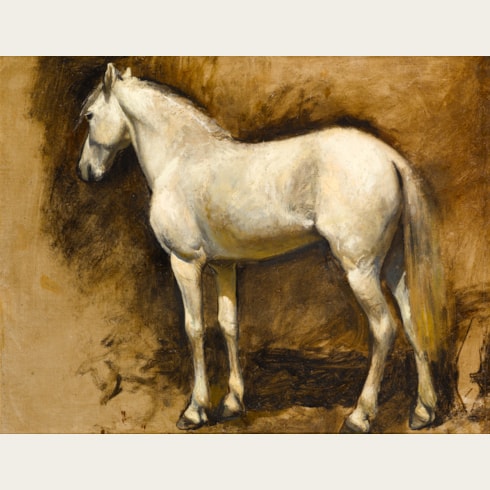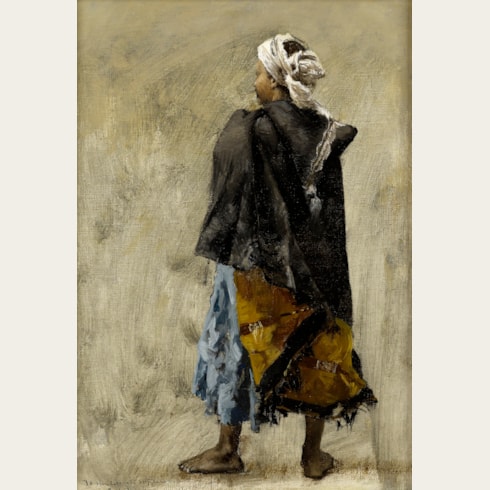Edwin Lord WEEKS
(Boston 1849 - Paris 1903)
Trees and a Wall in Jerusalem
Sold
Pencil on paper; a page from a large sketchbook.
A small sketch of a townscape in pencil on the verso.
Inscribed and dated Jerusalem Oct. 8th at the lower left.
Further inscribed Elizabeth Goodwin and numbered 3. on the verso.
254 x 367 mm. (10 x 14 1/2 in.)
A small sketch of a townscape in pencil on the verso.
Inscribed and dated Jerusalem Oct. 8th at the lower left.
Further inscribed Elizabeth Goodwin and numbered 3. on the verso.
254 x 367 mm. (10 x 14 1/2 in.)
The present sheet is part of a large collection of paintings, drawings and oil sketches by Edwin Lord Weeks, many dating from the years before his studies in Paris, which remained with the artist’s descendants until recently.
Views in Palestine are relatively rare in Week’s painted oeuvre. A painting of The Temple Mount in Jerusalem by the artist appeared at auction in London in 2010.
Views in Palestine are relatively rare in Week’s painted oeuvre. A painting of The Temple Mount in Jerusalem by the artist appeared at auction in London in 2010.
Little is known of Edwin Lord Weeks’s artistic training before 1874, when he enrolled in the studio of Léon Bonnat in Paris. By this time, however, he had already visited Morocco, Egypt, Palestine and Syria, and had exhibited several paintings inspired by this journey in his native city of Boston in 1874. His exposure to these exotic lands was to stand him in good stead with Bonnat and his friend Jean-Léon Gérôme, both of whom encouraged Weeks’s interest in Orientalist subjects. Weeks made his home in Paris, where he exhibited with great success at the annual Salons. He continued to travel to the Near East and North Africa, spending a considerable amount of time in Morocco between 1878 and 1880. He was one of the few Westerners to visit Rabat, Salé and Marrakech, and nearly died from typhoid fever. His Salon debut, in 1878, was with a painting of a Moroccan camel driver, and he continued to show Moroccan subjects for several years thereafter. (He also published an extensive account of his travels in Morocco in an article entitled ‘Two Centuries of Moorish Art’, which appeared in the April 1901 issue of Scribner’s Magazine.)
Between 1882 and 1893 Weeks made three long trips to India, taking not only paints and sketchbooks but also a camera, with which he recorded the architecture and landscape of the places he visited. In 1892 Weeks and a journalist, Theodore Child, travelled overland from Trebizond, on the Black Sea, to India, on an assignment sponsored by Harper’s Magazine. The artist produced numerous illustrations to supplement Child’s written dispatches, and eventually published a diary of this epic journey as From the Black Sea to India in 1896. Weeks remained in India for two years before returning home to Paris, where he was to live until his death. His views of India and Indian life proved extremely popular with French and American collectors, and became his particular specialty. He died in 1903 at the age of fifty-four, possibly from an illness contracted in India.
When the contents of his studio were dispersed at auction two years later, it was noted of Weeks that ‘Where the ordinary traveller has observed only squalor and misery, he has seen the enchanting glories of sunlight and shadow and the bewitching contrasts of color in costume, in architecture and in landscape. The native Indian with his mud hut, his chattie and his charpoy, has been to him but an episode to accentuate more strongly the sumptuousness of other phases of Oriental life...’
Provenance
By descent in the family of the artist to his niece, Elizabeth Goodwin
By descent to Burton W. F. Trafton, Jr., South Berwick, Maine
Mervyn E. Bronson, Portland, Maine
Bernard Broder, Gorham, Maine, until 2012.
Literature
To be included in the forthcoming Edwin Weeks catalogue raisonné in preparation by Dr. Ellen Morris.
Exhibition
Durham, University of New Hampshire, University Art Galleries, The Art of Edwin Lord Weeks, 1976, no.23 (as Jerusalem Trees, lent by Burton Trafton, Jr.).







